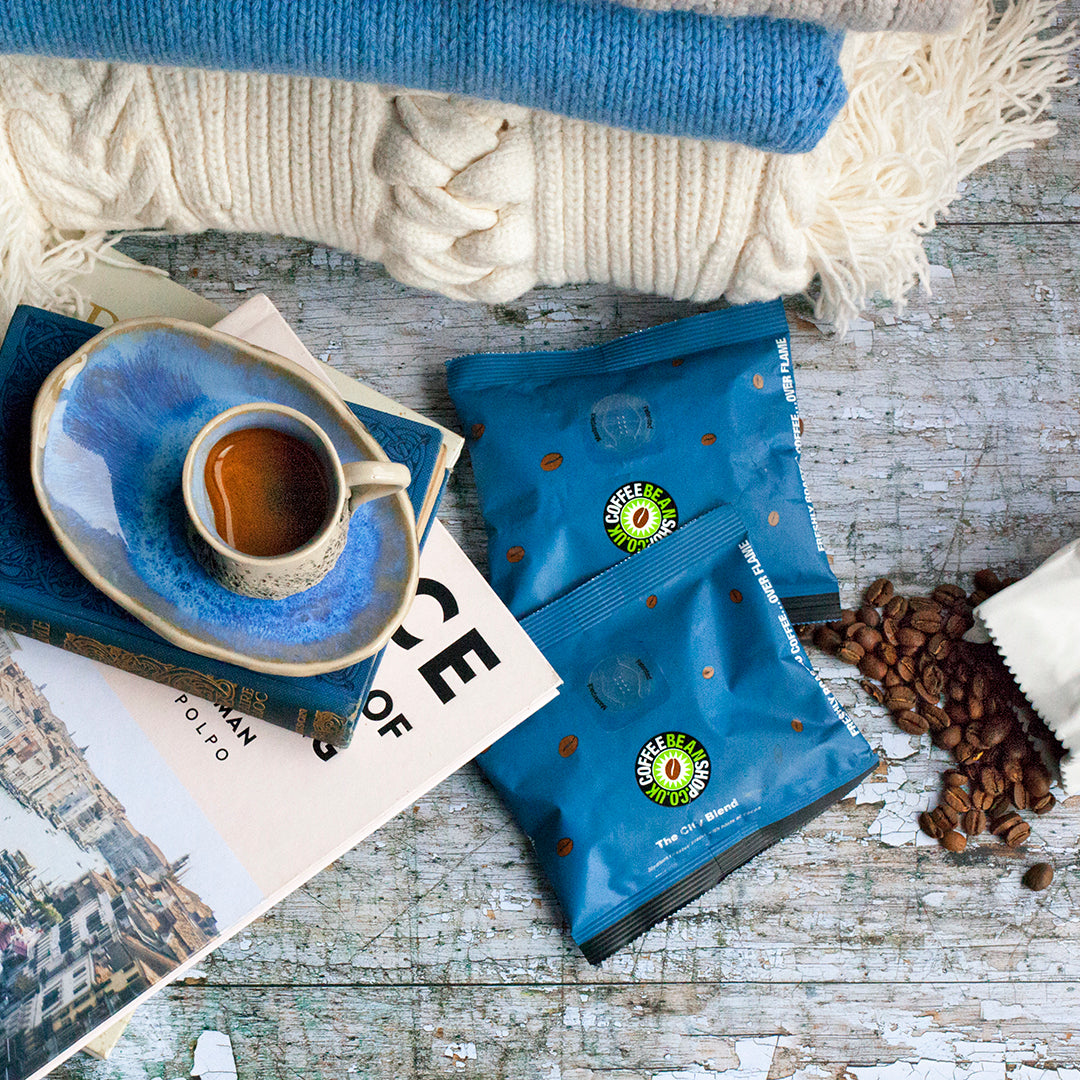Considered by many to be one of the great pleasures of life, the evocative taste and aroma of coffee has inspired a love affair so profound that around two billion cups are drunk across the world every day. But with a complex flavour profile, a great number of varieties and near-endless serving methods, the seemingly simple question, “what does coffee taste like?” is actually a rather intricate one.
Coffee fans may wonder exactly what it is about a cup of joe that makes it so irresistible, while those new to coffee may want to understand more about what to expect and which coffees they should try first. To understand more about the great taste and smell of coffee, read on below.
A Brief History of Coffee in Europe
Europe has been head-over-heels for coffee since its arrival from the Middle East and East Africa, with the drink travelling from its introduction in Hungary in 1526 to arrive in the UK in the mid-17th century. In fact, such was the allure and perceived exotism of coffee that some of Catholic Europe became concerned that it was inherently sinful, leading Pope Clement VIII to step in and declare “This devil’s drink is so delicious…we should cheat the devil by baptising it!”
By the end of the 17th-century historians estimate that there were 3,000 coffee houses in the UK, as a culture developed around conversation, exchanging news and hot delicious cups of ‘the devil’s drink’. From these early beginnings, the trend for speciality coffee and a flourishing cafe culture has made coffee in the modern world more popular than ever, with the increasing ubiquitousness of decaf options belying the idea that coffee’s popularity lies purely in its caffeine content.
Perhaps one of the biggest shifts in the UK over the last thirty years is an ever-growing appreciation for the depth and diversity of flavour on offer in the world of coffee. Just as sommeliers strive to appreciate the intricacies and multiplicities of wine, coffee lovers are keen to understand the tasting notes of coffee - treating coffee as an experience and a passion, rather than just a drink.
What Does Coffee Taste Like: The Brief Explanation
Coffee is flavoursome, fragrant and deeply rich in taste. It is often earthy with a discernible bitterness, but well-made coffee (using freshly roasted coffee beans) is defined by an enjoyable balance of flavours where sweet, bitter and acidic notes all work pleasantly together. Very often, people will recognise the tastes of chocolate, caramel, nuts and 'roast' in their coffee when it has been slowly roasted with care over flame.
Coffee should feel smooth when you drink it, without any particular flavour notes becoming jarring, but it is important to remember that there is a lot of variety in the coffee world. Depending on the type of coffee beans, how they are roasted and how the coffee is made, the taste of coffee can be anything from warm and mellow to bright and punchy, and the flavours can include the richness of vanilla to the vividness of summer fruits. If your cup of coffee tastes bitter - it’s burnt… simple! Each coffee should be delicately roasted to its optimum roast level.
The first choice for coffee drinkers in terms of choosing beans is whether they should enjoy a cup of 100% Arabica or an Arabica and Robusta blend of coffee. Arabica coffee is softer, sweeter and has a pleasant acidity, while Robusta coffee is stronger (with double the amount of caffeine) and has a more powerful taste. Another rarer type of coffee is Liberica, which is credited with a dark chocolate taste that has a hint of spice, but when it comes to flavour, the story doesn’t end there.
What Does Coffee Taste Like: A Little More Depth
It’s fair to say that all coffees share an essential 'coffeeness'; a deep, roasted flavour that people would recognise as coffee whatever kind of cup they were drinking. But with thousands of unique aromatic & flavour compounds (more even than wine) and a vastly complex chemical make-up, coffee flavours can vary according to where they were grown, the soil they were grown in, the altitude, the weather, how they were roasted and the ways in which they are served, alongside a myriad of other factors.
Coffee enthusiasts often use tasting notes to explore and discuss the flavour of coffee, which are a guide to aroma and taste profiles that help people find the distinguishing characteristics of different coffee types. These tasting notes are often split into categories such as “fruit”, “floral”, “nut”, “spice” and “vegetal”, from which more specific categories such as “blackberry” or “toffee” are gleaned.
This means, when a coffee connoisseur identifies a “cinnamon” flavour in coffee, they aren’t suggesting that cinnamon has been added to the drink, but that it is an inherent part of the flavour profile of those coffee beans and may well have been enhanced by the way those coffee beans were roasted. In fact, the chemical compounds which create a cinnamon flavour in coffee will be the same or extremely similar to the compounds in cinnamon itself.
The Beans
Coffee beans are grown all over the world, along what is known as the “coffee bean belt” in the Americas, Africa and Asia. Each region is famous for producing coffees of a particular flavour, with differing methods for growing and harvesting adding even more interesting factors into the mix. Generally speaking, Latin American coffees are mild, nutty and have low acidity with plenty of chocolaty overtones, while African coffees are bright and fruity and Asia produces coffees that are bold, earthy and sweet.
The Roasting Process
The roasting process has an enormous impact on the flavour of coffee. In fact, without roasting, the essential flavour of coffee wouldn’t exist as we know it, as the raw green beans are tasteless and smell of grass.
Roasting green coffee beans causes what's known as the Maillard reaction, in which amino acids and natural sugars undergo a chemical reaction that "cracks" the coffee beans as they expand and changes their smell, colour, density and flavour. We roast our coffee beans just into the second crack.
In a light roast, the coffee's original flavour takes centre stage, as the milder roasting process allows the intrinsic character of the beans to shine through. Medium roasts similarly accentuate the flavour of the beans (whether that's fruity, floral, chocolatey or anything in between) but with a darker and toastier note, while dark roasts are rich, smoky and intense, with the taste of the roast itself becoming the dominant flavour. A french roast, for example, has as much as 20% carbon and that is what a bitter burnt coffee tastes like .
Roasting coffee well and bringing out the best of the beans takes experience and expertise. There are several roasting faults that can impair a coffee's flavour, from baking, where the coffee is heated for too long without reaching the first crack, to tipping, where the tips of the beans become scorched because the drum is too hot. Understanding which roasts work most effectively with which beans is knowledge that can only be built by spending many years working with coffee.
Having covered the variety of beans and roasting methods, the third important factor that most influences coffee's flavour is the manner in which it is served.
Serving Style
The days in which uninspiring instant coffee was omnipresent feel long ago, with so many types of coffee to choose from that people are familiar with everything from a flat white to a frappuccino.
With all this variety on the market, we've decided to split coffee types into four main categories to explore their flavour - coffee and cream, coffee and milk, black coffee and sweetened coffee.
Coffee and Cream
A favourite of coffee-lovers in the USA, coffee and cream isn't quite as popular in Britain, but it is definitely worth trying just to experience the impact cream has on the flavour of coffee. Heavy cream has a transformative effect on coffee, with the fats in the cream and oils in the coffee interacting to change both the texture and taste.
Coffee with cream has more "body", tasting smoother and more indulgent than coffee taken alone or with milk. The cream also tends to iron out any bitter notes or rough edges, while retaining a richness of taste.
Coffee and Milk
Using a shot of coffee with milk is the most popular option in both the US and UK, with polls suggesting that lattes are the most-ordered drinks in coffee shops on both sides of the pond. Additionally to this, many people add a splash of milk to their coffee in the same way as they will for tea, achieving a similar if less pronounced effect as cream - essentially, smoothing out the intense coffee flavours.
Coffees such as lattes, cappuccinos and flat whites are made mostly from milk, and result in a drink that tends to feel more sumptuous, smooth and mild than black coffee.
Black Coffee
This is coffee in its purest form, and is often favoured by those who like to experience coffee's authentic and unadulterated taste. Black coffees may be watered down (such as an Americano) or served as an intense shot in the form of espresso. The result is a more vibrant and distinctive taste, where the roast and the beans shine through.
Sweetened Coffee
Coffee also stands up very well to the addition of other flavours and sweeteners. Sugar is the most obvious one, but people also enjoy a range of syrups (from vanilla to the infamous pumpkin spice) which add both sweetness and other tasting notes to their drink. When used thoughtfully, syrups can enhance and complement coffee's natural flavours, while the classic pairing of coffee and chocolate works excellently in a cup of mocha.
***
With so many aromas and flavour notes interweaving to create this globally loved beverage, there is a lot to think about when we consider what coffee tastes like. One thing for certain, however, is that the irresistible flavour of coffee is sure to remain as popular and well-loved as it has been since human beings brewed their first cup.

